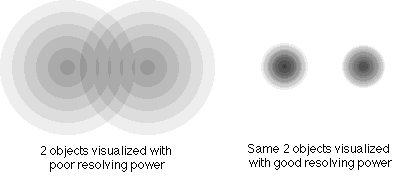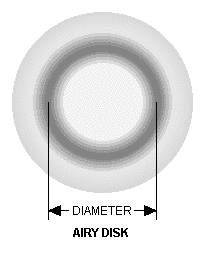Resolving Power
Claimed by estaniforth3
The Main Idea
Resolving power is the measure of an optical system's ability to differentiate between the images of objects close together or separate similar wavelengths of radiation and therefore display fine detail. In an ideal situation, this quantity is dependent on two components of the radiation, the aperture (the space through which light passes in an optical system) and wavelength (the distance between crests in a wave). However in real life applications the resolving power is limited by the effects of diffraction, the effect on a wave when it encounters an obstacle.

The Rayleigh Criterion for Minimal Image Resolution
Lord Rayleigh (John William Strutt) determined that, given two point light sources, the center of the image of the first source will fall on the first diffraction ring of the second source. Because of this, there is a minimum angle (in radians) between the two sources (as viewed by the system) for the two sources to be at least marginally resolvable (distinguishable). In ideal circumstances it would be defined as [math]\displaystyle{ \frac{λ}{a} }[/math], however factoring in diffraction:
Angular limit of Resolution [math]\displaystyle{ = \frac{1.22λ}{a} }[/math]
λ - wavelength in meters, [math]\displaystyle{ a }[/math] - diameter of the aperture in meters
The resolving power can be found by calculating the inverse of the angular limit of resolution.
Resolving power [math]\displaystyle{ = \frac{a}{1.22λ} }[/math]
λ - wavelength in meters, [math]\displaystyle{ a }[/math] - diameter of the aperture in meters
Dawes and Rayleigh limits
However once you reach the scale of stars and telescopes, there are three different possible scenarios.
When the two stars have very little angular separation, although the theory may suggest that an increased aperture or magnification would suffice in resolving the two images, diffraction proves this untrue. Each star cannot be considered a point of light but instead a disk of light. If there is too much overlap then increased aperture or magnification simply amplifies the blur of light.
However, in the case that the stars' Airy disks touch, the two stars are at Dawes limit. In this situation it is possible to differentiate them and determine the minimum angle with, [math]\displaystyle{ \frac{12}{a} }[/math] arc seconds. ([math]\displaystyle{ a }[/math] - diameter of the aperture in meters)
If the center of the Airy disk of one star falls on the first dark ring of other star's diffraction pattern. These too can be distinguished and the minimum angle is calculated with [math]\displaystyle{ \frac{13}{a} }[/math] arc seconds. ([math]\displaystyle{ a }[/math] - diameter of the aperture in meters)

Though these are tried and tested, they are not infallible and are not iron-fast rules. In 1978, Pluto's satellite Charon could not be resolved despite the fact that it was much higher than the limiting angle for large telescopes. It was only detected as an elongated photographic image.
Applications
There are many applications to this concept as it is an integral part of how we use lenses, here are just a few.
Telescopes
For example, we can apply this understanding to explain the optical phenomenon called black drop. It elongates the silhouettes of Venus and Mercury against the Sun's disk in photographs and telescopic projections. This phenomenon distorts the image so the planet looks like a tear drop. Although it does not appear like the blurring expected from inadequate resolving power, this is the result of a combination of the Earth's atmosphere's instability and the resolving power of the optical instrument used in creating the image.
Microscopes
This concept can also be applied to microscopes, an instrument familiar to most science students. The maximum resolving power of the human eye, also called visual acuity, is only ~0.5 minutes of arc. Microscopes work to increase that so we can see small images with great clarity. For example, electron microscopes get higher resolving power because they have shorter wavelengths.
Connectedness
- How is this topic connected to something that you are interested in? Before I decided to being a Computational Media major, I had originally wanted to pursue something in biotechnology or biomedical science. One of my favorite units was histology because we got to work with the microscopes. I enjoyed learning part of what makes them work. I also never took Astronomy in high school so learning something related to a discipline so foreign to me was very interesting.
- How is it connected to your major? This isn't all that related to my major specifically, however as a Computational Media major anything that can be computing is technically related. There is a lot of work in software that increases the quality of photographs.
- Is there an interesting industrial application? Industrially, not in the telescope department since a large part of this theory is on far too large a scale to be commercial. However, this does apply to microscopes, an integral part of high school science classes. Higher level classes like AP Biology, AP Environmental Science and Anatomy & Physiology benefit from high resolving power microscopes.
See also
Further reading
Pedrotti, Frank L., Leno M. Pedrotti, and Leon S. Pedrotti. Introduction to Optics, 3rd ed. San Francisco: Addison Wesley, 2007.
Serway, Raymond A., Jerry S. Faughn, Chris Vuille, and Charles A. Bennet. College Physics, 7th ed. Belmont, Calif.: Thomson Brooks/Cole, 2006.
Young, Hugh D., and Roger A. Freedman. University Physics, 12th ed. San Francisco: Addison Wesley, 2007.
External links
Internet resources on this topic
References
"Black Drop." Dictionary of Astronomy, Fifth Edition. Facts On File, 2006. Science Online. Web. 6 Dec. 2015. <http://online.infobase.com/HRC/Search/Details/290830?q=resolving power>.
"Optics." Encyclopedia of Physical Science. Facts On File, 2009. Science Online. Web. 2 Dec. 2015. <http://online.infobase.com/HRC/LearningCenter/Details/8?articleId=299135>.
"Rayleigh Criterion." Encyclopedia of Physical Science. Facts On File, 2009. Science Online. Web. 6 Dec. 2015. <http://online.infobase.com/HRC/Search/Details/298702?q=rayleigh>.
"Resolving Power." Dictionary of Physics, Fourth Edition. Facts On File, 2005. Science Online. Web. 6 Dec. 2015. <http://online.infobase.com/HRC/Search/Details/304452?q=resolving power>.
"Visual Acuity." Dictionary of Physics, Fourth Edition. Facts On File, 2005. Science Online. Web. 6 Dec. 2015. <http://online.infobase.com/HRC/Search/Details/305359?q=resolving power>.